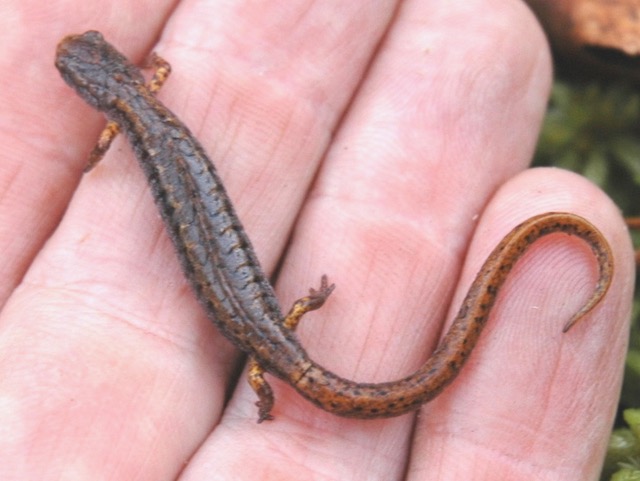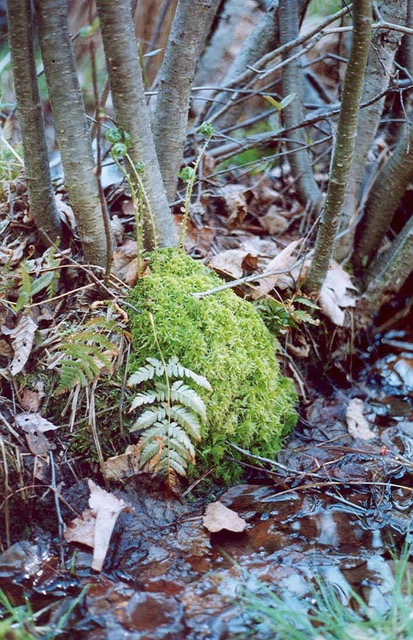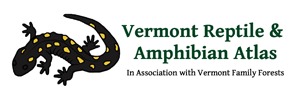
Herp Update: Current Herp Activity, Amphibians of Vermont Pocket Guide – April 7, 2023
Current Herp Activity
Herpers, the photographs and records have been pouring in over the last week. Almost all of these reports are coming from the lowlands of western Vermont (from Arlington north to Milton) with only a few reports for anywhere else in Vermont (Norwich, Putney, and Royalton). As you may know, parts of the state are still covered in snow and amphibian migration is yet to begin in those places. Multiple records came in from March 23, 31, April 1, 3, 5, and 6. These reports were primarily the amphibians that move earliest in the spring (Jefferson, Blue-spotted, Spotted, and Four-toed Salamanders; and Spring Peepers and Wood Frogs). At one site, a huge number (325) of Eastern Newts were seen crossing a road. This is really unusual. They appear to have been newts that were changing from their terrestrial Red Eft stage to their adult breeding stage, and returning to water.
Four-toed Salamanders
But, back to the Four-toed Salamanders. Regular contributor Sarah Allen has sent in many useful reports. Last week she sent in the first report ever of a Four-toed Salamander from Pittsford, VT. Herp Atlas data entry expert Cindy Brown sent in a Four-toed report from a new site in Hubbardton. Additional reports have come in from previously known locations for this species such as Morgan Road in Salisbury and Hibbard Road in Milton. There are huge gaps in our knowledge of the distribution of this species. We really need more people looking at these relatively short and skinny little salamanders that are impossible to see from a car.
There are really only three salamanders crossing into wetlands at this time of year that could be described as short and skinny. Juvenile Blue-spotted Salamanders (and the hybrids that breed with them), move to wetlands in the spring along with the adults. These youngsters are not old enough to breed. They are just moving from wintering spots in well-drained woods down into the wetlands and swamp edges for the feeding season. A close look at these guys, will reveal that although they are tiny, they already have a bit of a round belly.
Also moving down into the wetland edges at many locations are Eastern Red-backed Salamanders. Red-backs are not pool or even water breeders, but at many sites (but not all) these species migrate in large numbers during the spring and fall. They move down into the wetland edges in the spring to feed and reproduce. Then they migrate back up into the woods in the fall to overwinter.
The third of these three skinny salamanders are the Four-toed Salamanders. They are moving into the wetlands in order to lay their eggs above the water line, but where their youngsters can drop vertically into the water when they hatch. So, they lay their eggs under moss on logs, tree trunks, and on tussocks that are in the water. They require structure within their breeding wetlands. The water may be a vernal pool, a wooded swamp, or the edge of a sedge swamp, but they need structure and usually shade (for the moss) in their breeding pools.
The easiest way to identify Four-toed Salamanders is to pick them up and look at their undersides. They are very easy to catch compared to the quick and evasive Eastern Red-backed Salamanders. Once turned over, you will see their bright-white bellies (venters) with scattered black dots. No other salamander in Vermont has this pattern on their bellies. With experience you will also notice that these salamanders have a different dorsal (back) color, texture, and shape (including a constriction at the base of their tails) than the very similar Eastern Red-backeds.
Please do be on the lookout for this rarely reported species. I have attached photos showing their dorsum (taken by Chris Slesar), their venter (taken by Kiley Briggs), and an example of their breeding location (taken by Jean Francois DesRoches). I hope you can find one and if you do, please take a picture and send us a report.



Don’t miss out on our Amphibians of Vermont Pocket Guide
We have received many orders for our new Amphibians of Vermont pocket guide that was produced in collaboration with Teage O’Conner of Crow’s Path. This is the first and only guide for the amphibians of Vermont. This small folding guide easily fits in your pocket and has detailed color paintings of all of Vermont’s frogs and salamanders along with our latest distribution maps and descriptions. You can see and order it ($15) through our website at:
Happy herping!

